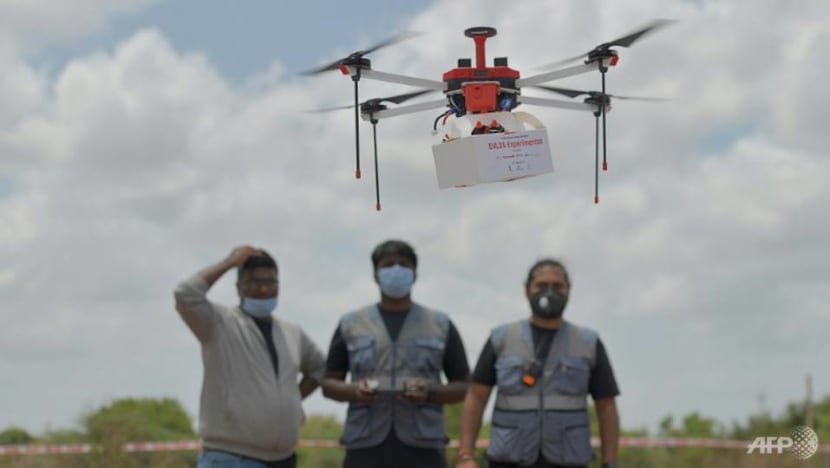live Commentary
Commentary: Why drone regulations shouldn’t take flight over fear

Greater use of drones could be a game-changer for medical services in the South Asian nation's hard-to-reach rural areas where health care is limited and roads often poor. (Photo: AFP/Manjunath Kiran)

This audio is generated by an AI tool.
As a beginner drone pilot, I remember my first crash vividly.
Before that flight, I was meticulous about preparation. I carefully inspected my equipment, double-checked the radio transmitter and batteries, and walked two laps around the flying area to familiarize myself with potential obstacles and ensure it was devoid of people. Crucially, I verified using the government mapping tool OneMap to ensure the location was not within one of Singapore's densely marked no-fly zones.
Despite these extensive precautions, disaster still struck. My drone clipped a tree branch mid-flight, spiraled dramatically, and crashed onto the field. Thankfully, no one was around to be injured, though my drone's expensive camera system was destroyed, leaving behind only the memory captured in high-definition footage.
This incident left me deeply conscious of the responsibilities inherent in operating drones, powerful and agile machines that require careful management and accountability.
Across Singapore, drones have surged in popularity, especially remote-controlled quadcopters, now frequently seen buzzing above permitted fields like those at Pandan Reservoir and Dover Road.
Unsurprisingly, there have been notable incidents over recent years: drones causing disruptions at Changi Airport, landing on MRT tracks, and even being struck by moving trains. More recently, incidents at a condominium in one-north and Methodist Girls’ School (MGS) have elevated public concerns significantly.
The MGS incident gained particular attention, with court documents describing how windy conditions led a remotely controlled plane to crash dangerously close to people, leaving craters upon impact.
The pilot was fined S$7,000 under the Air Navigation Act.
Collectively, these events portray drones as potential hazards, prompting concerns that drone usage might represent a ticking time bomb.
Public Safety vs. Technological Innovation
These events highlight a global debate: should stricter drone regulations be introduced? On one side, proponents argue that drones are too risky in Singapore’s crowded skies and suggest banning their usage near schools, parks, or residential areas to prevent accidents.
On the other, drone enthusiasts and innovators highlight the significant benefits drones offer, arguing that excessive restrictions could stifle valuable technological advancements.
Indeed, outside of just recreational flight, drones have transformed sectors like agriculture, logistics, emergency response, and surveillance. They enable delivery of critical supplies to remote areas and support vital disaster relief operations, highlighting their immense potential benefits globally.
Here, the work has already started on developing guidelines for electric vertical take-off and landing aircraft – air taxis, for example, as well as greater applications for unmanned drones that can transform the way we work, live and commute.
Aerial food deliveries via unmanned drones, as what I witnessed in a recent trip to Shenzhen, China, is a distinct possibility here.
The Civil Aviation Authority of Singapore (CAAS) in April called for feedback on such industry guidelines to be submitted to the International Civil Aviation Organization in September.
Penalising the Responsible
However, we are at a stage where technology has not yet fully matured. Crashes—due to novice errors, unforeseen mishaps, or occasionally negligence—are inevitable.
What’s needed are regulations that specifically target irresponsible users without unfairly penalizing those who follow safety guidelines meticulously.
Unfortunately, imposing increasingly stringent regulations often disproportionately impacts responsible pilots rather than deterring reckless operators.
This dilemma is notably playing out in the United States with the controversial implementation of RemoteID, an accountability measure prompting heated discussions around privacy, costs, and unfair burdens on compliant drone operators.
Essentially, RemoteID is a transponder or module installed on drones so that people on the ground – the authorities, in particular – know whose drone is in the air.
But there is a view that by mandating that drones above 250g broadcast their location and identification to everyone, members of the public will also be able to find out who is flying, track down the location of the drone pilot simply by using a smartphone app, and harass them.
The problem here is that this increases scrutiny on compliant drone users who want to stay legal and install these broadcast modules.
Such debates underline the importance of measured regulation that focuses clearly on deterring unsafe practices rather than imposing unnecessary burdens on responsible pilots.
The Future: Innovation with Responsibility
Singapore already maintains strict zonal restrictions around sensitive areas, including airports and military facilities.
Some advocate expanding these restrictions to areas near schools and densely populated neighborhoods. However, overly restrictive measures may unintentionally inhibit beneficial drone innovations without significantly improving safety.
The CAAS-approved designated drone area in Dover Road, for example, is a stone’s throw away from Singapore Polytechnic, UWC South East Asia Dover, and a preparatory school. Should flight restrictions be expanded to educational institutions, then the drone community may just lose one of two dedicated flying areas that have amenities catered to pilots.
Instead, Singapore is wisely pursuing a more nuanced approach. From December 1, 2025, the CAAS will introduce the Broadcast Remote Identification (BRID) as part of a broader air traffic management system.
The technology sounds similar to RemoteID in the US, with one difference – [clarifying]
To me, this is a way of enhancing drone accountability without unduly restricting legitimate drone use.
Drones sold in Singapore will come pre-installed with BRID, allowing authorities to swiftly detect and penalise operators who flout regulations by flying dangerously or in unauthorized zones. This measure significantly boosts accountability, clearly communicating to pilots that their actions are monitored.
Moreover, eligible drone pilots can install BRID at no additional cost, thanks to subsidies provided by CAAS, ensuring responsible pilots are not unfairly burdened financially. As a whole, BRID facilitates safer skies, essential for managing future complex drone operations such as drone deliveries and unmanned air taxis.
Of course, bad actors may choose to circumvent compliance of any sort. Addressing these individuals requires separate targeted enforcement strategies, distinct from broad-based regulations designed to encourage responsible flying.
Ultimately, cultivating a culture of responsible drone operation through community education and proactive engagement is likely more effective than reactionary, restrictive policies.
Responsible innovation strikes the optimal balance—allowing drone technology to thrive safely and sustainably, benefiting everyone in society.











